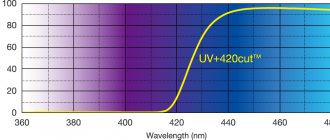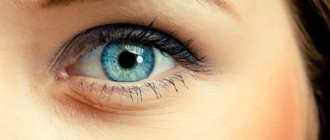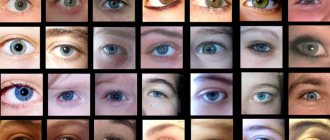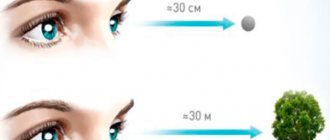Today, the question very often arises about the potential danger of ultraviolet radiation and the most effective ways to protect the organ of vision.
- What is ultraviolet radiation?
- What ranges does ultraviolet radiation have?
- What does the name “ultraviolet” mean?
- Where does ultraviolet radiation come from?
- What determines the intensity of exposure to ultraviolet radiation?
- What is the effect of ultraviolet radiation on the human body?
- What danger does ultraviolet radiation pose to the organ of vision?
- What eye protection products are there?
- What standards regulate the light transmission of sunglasses lenses?
- Is it true that ultraviolet radiation is more dangerous if a person wears low-quality sunglasses?
- What optical material for spectacle lenses provides UV protection?
- Is it true that the effectiveness of UV protection for photochromic lenses is determined by their light absorption in the activated stage?
- Does dark lens color guarantee UV protection?
- Should UV absorber be added to clear lenses?
- How can you make sure your lenses provide UV protection?
Today, the question very often arises about the potential danger of ultraviolet radiation and the most effective ways to protect the organ of vision. We have prepared a list of the most frequently asked questions about ultraviolet radiation and the answers to them.
What is ultraviolet radiation?
The spectrum of electromagnetic radiation is quite broad, but the human eye is sensitive only to a certain region called the visible spectrum, which covers the wavelength range from 400 to 700 nm. Radiations that are beyond the visible range are potentially hazardous and include infrared (wavelengths greater than 700 nm) and ultraviolet (less than 400 nm). Radiations that have a shorter wavelength than ultraviolet are called x-rays and γ-rays. If the wavelength is longer than that of infrared radiation, then these are radio waves. Thus, ultraviolet (UV) radiation is electromagnetic radiation invisible to the eye, occupying the spectral region between visible and X-ray radiation within the wavelength range of 100–380 nm.
What ranges does ultraviolet radiation have?
Just as visible light can be divided into components of different colors, which we see when a rainbow appears, so the UV range, in turn, has three components: UV-A, UV-B and UV-C, with the latter being the shortest wavelength and highest energy ultraviolet radiation with a wavelength range of 200–280 nm, but it is mainly absorbed by the upper layers of the atmosphere. UVB radiation has a wavelength of 280 to 315 nm and is considered medium energy radiation that is hazardous to the human eye. UV-A radiation is the longest wavelength component of ultraviolet with a wavelength range of 315–380 nm, which has maximum intensity when it reaches the Earth's surface. UV-A radiation penetrates biological tissues most deeply, although its damaging effect is less than that of UV-B rays.
Effect of ultraviolet radiation on the eyes
Why is UV harmful?
UV with a wavelength of 280-315 nm affects the cornea, and at 315-380 nm it is almost completely absorbed by the lens, but part of it reaches the retina, which can provoke a deterioration in visual abilities.
The danger of ultraviolet radiation lies in its ability to accumulate in the body, which provokes the formation of an increased amount of free radicals that destroy RNA, DNA and protein compounds. The constant degenerative process leads to a gradual weakening of visual abilities, as well as the development of eye diseases.
The result of such an effect on the child’s lens can be cataracts.
In children, the lens, which acts as a natural filter for ultraviolet radiation, is more exposed to negative effects. At a younger age, the transparent body copes worse with stress and transmits up to 70% of rays into the retina. There is also destruction of the protein compounds of the lens, modifying the structure of the eye element. The consequence is a process of clouding, which provokes the appearance of cataracts. With frequent exposure, the lens may become less elastic, and the child will lose the ability to clearly see nearby objects.
Brief but intense exposure to ultraviolet radiation on the eye, which occurs when looking at a working welding machine, open sun high in the mountains, or medical devices, causes thermal burns. The damage requires long-term medical treatment and is fraught with deterioration or loss of visual abilities.
Effects of ultraviolet radiation
Due to radiation in the range from 280 to 400 nm, the following dangerous eye conditions can develop:
Radiation can cause intense lacrimation.
- children's farsightedness;
- cataract;
- malignant tumor;
- retinal burn;
- deterioration of visual abilities;
- increased lacrimation;
- partial or complete blindness;
- burning, itching and pain in the eyes.
Who is at high risk?
The likelihood of developing eye complications due to ultraviolet irradiation from artificial and natural sources is especially high in the following categories of people:
- patients after surgical removal of cataracts;
- workers of medical institutions;
- patients who have undergone a therapeutic photodynamic course;
- welders;
- owners of light shades of the iris;
- athletes who are often exposed to the sun;
- solarium visitors;
- children living in sunny areas;
- patients taking medications to increase sensitivity to light - tranquilizers and diuretics.
What does the name “ultraviolet” mean?
This word means “above (above) violet” and comes from the Latin word ultra (“above”) and the name of the shortest radiation in the visible range - violet. Although UV radiation is not detectable by the human eye, some animals - birds, reptiles, and insects such as bees - can see in this light. Many birds have plumage colors that are invisible under visible light conditions, but clearly visible under ultraviolet light. Some animals are also easier to spot in ultraviolet light. Many fruits, flowers and seeds are perceived more clearly by the eye in this light.
Features of the visual system of humans and animals
The structure of people's eyes is such that they cannot see in complete darkness. Only in conditions of artificial or natural lighting is a person able to clearly distinguish surrounding objects. The eyes of animals, insects and birds are designed differently. Their visual system is characterized by a number of properties that arise due to the characteristics of their habitat. Animals' vision helps them protect themselves from attacks and find food. People do not have super vision, but for a comfortable life we have enough of the abilities that nature has endowed. Human eyes can see objects only if light rays reflect from them and hit the retina.
Where does ultraviolet radiation come from?
Outdoors, the main source of UV radiation is the sun. As already mentioned, it is partially absorbed by the upper layers of the atmosphere. Since a person rarely looks directly at the sun, the main damage to the organ of vision occurs as a result of exposure to scattered and reflected ultraviolet radiation. Indoors, UV radiation occurs when using sterilizers for medical and cosmetic instruments, in tanning salons, during the use of various medical diagnostic and therapeutic devices, as well as when curing filling compositions in dentistry.
In solariums, UV radiation occurs to form a tan.
In industry, UV radiation is generated during welding operations at levels so high that they can cause serious damage to the eyes and skin, which is why the use of protective equipment is mandated for welders. Fluorescent lamps, widely used for lighting at work and at home, also produce UV radiation, but the level of UV radiation is very low and does not pose a serious danger. Halogen lamps, which are also used for lighting, produce light with a UV component. If a person is close to a halogen lamp without a protective cover or shield, the level of UV radiation can cause serious eye problems.
In industry, UV radiation is generated during welding operations at levels so high that they can cause serious damage to the eyes and skin.
Which tissues and organs of the eye are damaged by ultraviolet radiation?
The most dangerous of all forms of UV radiation are ultra-short rays of type "C", but they practically do not reach the surface of our planet. UVB radiation is the second most influential radiation on our eyes. It penetrates deep into the structure of cells and starts the process of their destruction. Type A rays are the least harmful: they can only affect superficial tissues without penetrating into internal organs.
The degree of influence of UV rays on living cells depends on the duration, intensity and area of their exposure.
Let's look at how ultraviolet radiation affects different structures of the eye.
Conjunctiva (mucous membrane of the eye)
The mucous membrane of the eye is extremely vulnerable to sunlight: they trigger oxidative processes and cause cell death. With prolonged exposure to ultraviolet radiation, malignant neoplasms of the conjunctiva often develop.
Cornea
UVB radiation is particularly dangerous for corneal tissue: it damages the layer of protective antioxidants and causes irreversible cell destruction. As a result, photokeratitis develops - inflammation of the cornea, which can lead to poor vision and even blindness.
Lens
When exposed to UV radiation, the lens becomes cloudy and loses transparency. It has been proven that it absorbs rays of types A and B, and they, in turn, provoke the development of cataracts.
Retina
Thanks to the filtering effect of the lens, about 1–2% of ultraviolet radiation reaches the retina. However, even this exposure may be sufficient to cause early age-related macular degeneration.
Thus, ultraviolet radiation has a negative effect on all organs and tissues of the eye. This influence has a cumulative effect: a person may not notice an emerging problem for several years, and then discovers a serious and already advanced form of the disease.
What determines the intensity of exposure to ultraviolet radiation?
Its intensity depends on many factors. Firstly, the height of the sun above the horizon varies depending on the time of year and day. During the daytime in summer, the intensity of UV-B radiation is highest. There is a simple rule: when your shadow is shorter than your height, you risk receiving 50% more of this radiation.
Secondly, the intensity depends on geographic latitude: in equatorial regions (latitude close to 0°) the intensity of UV radiation is the highest - 2-3 times higher than in northern Europe. Third, intensity increases with increasing altitude because the layer of atmosphere capable of absorbing ultraviolet light is correspondingly reduced, so more of the highest-energy short-wave UV radiation reaches the Earth's surface. Fourthly, the intensity of radiation is affected by the scattering ability of the atmosphere: the sky appears blue to us due to the scattering of short-wavelength blue radiation in the visible range, and even shorter-wavelength ultraviolet radiation is scattered much more strongly. Fifthly, the intensity of radiation depends on the presence of clouds and fog. When the sky is cloudless, UV radiation is at its maximum; dense clouds reduce its level. However, clear and sparse clouds have little effect on UV radiation levels; water vapor from fog can lead to increased ultraviolet scattering. A person may feel cloudy and foggy weather as colder, but the intensity of UV radiation remains almost the same as on a clear day.
When the sky is cloudless, UV radiation is at its maximum
Sixth, the amount of reflected ultraviolet radiation varies depending on the type of reflective surface. Thus, for snow, reflection is 90% of the incident UV radiation, for water, soil and grass - approximately 10%, and for sand - from 10 to 25%. You need to remember this while on the beach.
What is the effect of ultraviolet radiation on the human body?
Prolonged and intense exposure to UV radiation can be harmful to living organisms - animals, plants and humans. Note that some insects see in the UV-A range, and they are an integral part of the ecological system and in some way benefit humans. The most famous result of the influence of ultraviolet radiation on the human body is tanning, which is still a symbol of beauty and a healthy lifestyle. However, prolonged and intense exposure to UV radiation can lead to the development of skin cancer. It is important to remember that clouds do not block ultraviolet light, so a lack of bright sunlight does not mean that UV protection is not needed. The most harmful component of this radiation is absorbed by the ozone layer of the atmosphere. The fact that the thickness of the latter has decreased means that UV protection will become even more important in the future. Scientists estimate that a decrease in the amount of ozone in the Earth's atmosphere by just 1% will lead to an increase in skin cancer by 2–3%.
Negative effects of ultraviolet radiation on humans
Despite its important role in medicine, the harm of ultraviolet radiation on health outweighs the benefits - most people are not able to accurately control the therapeutic dose of ultraviolet radiation and resort to protection methods in a timely manner, so its overdose often occurs, which causes the following negative effects:
- headaches appear;
- body temperature rises;
- fatigue, apathy;
- memory impairment;
- cardiopalmus;
- decreased appetite and nausea.
Excessive tanning affects the skin, eyes and immune (defense) system. The tangible and visible consequences of excessive UV irradiation (burns of the skin and mucous membranes of the eyes, dermatitis and allergic reactions) disappear within a few days. Ultraviolet radiation accumulates over a long period of time and causes very serious diseases.
The effect of ultraviolet radiation on human skin
A beautiful, even tan is the dream of every person, especially the fairer sex, but it should be understood that skin cells darken under the influence of the coloring pigment released in them - melanin in order to protect against further ultraviolet irradiation. Therefore, tanning is a protective reaction of our skin to damage to its cells by ultraviolet rays . But it does not protect the skin from the more serious effects of UV radiation:
- Photosensitivity – increased sensitivity to ultraviolet radiation. Even a small dose of it causes severe burning, itching and sunburn of the skin. This is often associated with the use of medications or the consumption of cosmetics or certain foods.
- Photoaging. UV rays of spectrum A penetrate into the deep layers of the skin, damaging the structure of connective tissue, which leads to the destruction of collagen, loss of elasticity, and early wrinkles.
- Melanoma is skin cancer . The disease develops after frequent and prolonged exposure to the sun. Under the influence of an excessive dose of ultraviolet radiation, malignant formations appear on the skin or old moles degenerate into a cancerous tumor.
- Basal cell and squamous cell carcinoma are non-melanoma skin cancers that are not fatal but require surgical removal of the affected areas. It has been noticed that the disease occurs much more often in people who work in the open sun for a long time.
Any dermatitis or phenomena of skin sensitization under the influence of ultraviolet radiation are provoking factors for the development of skin cancer.
The effect of ultraviolet radiation on human eyes
Ultraviolet rays, depending on the depth of penetration, can negatively affect and reflect on the condition of a person’s eyes:
- Photoophthalmia and electroophthalmia. Expressed in redness and swelling of the mucous membrane of the eyes, lacrimation, photophobia. Occurs when safety rules are not followed when working with welding equipment or in people who are in bright sunlight in a snow-covered area (snow blindness).
- Growth of the conjunctiva of the eye (pterygium).
- Cataract (clouding of the lens of the eye) is a disease that occurs to varying degrees in the vast majority of people in old age. Its development is associated with exposure to ultraviolet radiation on the eyes, which accumulates throughout life.
Excess UV rays can lead to various forms of eye and eyelid cancer.
The effect of ultraviolet radiation on the human immune system
If dosed use of UV radiation helps to increase the body's defenses, then excessive exposure to ultraviolet radiation suppresses the immune system . This has been proven in scientific studies by US scientists on the herpes virus. Ultraviolet radiation changes the activity of cells responsible for immunity in the body; they cannot restrain the proliferation of viruses or bacteria, cancer cells.
What danger does ultraviolet radiation pose to the organ of vision?
There are serious laboratory and epidemiological data linking the duration of exposure to ultraviolet radiation with eye diseases: cataracts, macular degeneration, pterygium, etc. Compared with the lens of an adult, a child’s lens is significantly more permeable to solar radiation, and 80% of the cumulative effects of exposure to ultraviolet waves accumulate in the human body until he reaches the age of 18. The lens is most exposed to radiation immediately after the baby is born: it transmits up to 95% of the incident UV radiation. With age, the lens begins to acquire a yellow tint and becomes less transparent. By age 25, less than 25% of incident ultraviolet rays reach the retina. In aphakia, the eye is deprived of the natural protection of the lens, so in this situation it is important to use UV-absorbing lenses or filters. It should be borne in mind that a number of medications have photosensitizing properties, that is, they increase the consequences of exposure to ultraviolet radiation. Optometrists and optometrists must have an understanding of a person's general condition and medications in order to make recommendations regarding the use of protective equipment.
Is ultraviolet radiation really that dangerous?
Most people easily draw a parallel between solar radiation and skin cancer.
But rarely does anyone realize the connection between these same rays and serious eye diseases.
Which rays are most dangerous, when and why? Let's figure it out.
UV radiation is invisible to the human eye. It consists of rays of different lengths.
- UV-A category rays reach a length of 315-400 nm. They pass almost unhindered through the atmosphere and penetrate the tissues most deeply.
- UV-B rays are 280-315 nm in length and mostly do not pass through the ozone layer. But it is the portion of high-energy light that does reach the Earth's surface that causes the most harm.
- UV-C category rays are 280-200 nm in length, they are blocked by the ozone layer and practically do not reach the Earth's surface.
The source of UV rays is the Sun. Most people think, but it is only harmful to be in direct sunlight. But in fact, reflected rays are no less dangerous.
For example, up to 85% of rays are reflected from snow cover; from concrete and dry sand approximately 25%; from grass – 3%. Also, the rays are perfectly reflected from the surface of the water. Thus, even if we are in the shade, we are exposed to solar radiation.
By the way, artificial light sources (energy-saving lamps, fluorescent lamps, solarium lamps, bactericidal lamps, etc.) often also emit ultraviolet radiation.
So, we receive our dose of radiation not only while on the street, but even within the walls of our home or office.
Although ultraviolet rays rarely reach the retina of an adult eye, they do damage the cornea and lens. You've probably noticed how, as a person gets older, the lens of the eye begins to yellow, which can develop into cataracts.
Children spend much more time outdoors than adults. This means they are even more susceptible to ultraviolet radiation.
A child's not fully formed eye is more exposed to the harmful effects of UV radiation.
Thus, during the first year of life, 90% of UV-A and 50% of UV-B rays reach the retina.
At the age of 10-13 years, the same happens with 65% and 25% of rays, respectively.
The younger the child, the more his eyes are exposed to the harmful effects of solar radiation.
By the age of 18, a person has already received 25% of the radiation that usually occurs during a lifetime.
Let's figure out how much and what kind of rays are able to penetrate the tissues of the eye.
- The tear film absorbs rays whose length is below 290 nm.
- A healthy cornea prevents the passage of rays up to 300 nm in length.
- The lens of an adult human eye blocks almost all UV rays up to 390 nm in length. The vitreous body “catches” rays whose length is up to 290 nm.
- And only about 5% of UV rays reach the surface of the retina of an adult.
A fully formed eye has a protective mechanism that virtually prevents ultraviolet radiation from damaging the retina. Although the risk of damage to the cornea and lens of the eye remains high throughout life.
Therefore, it is important to protect your eyes!
Sunglasses or frames with clear lenses of medium and high indexes protect your eyes 100% from direct sunlight. But the rays reflected from the back surface of the lenses are still able to penetrate the tissues of the eye. Therefore, the most complete eye protection is achieved by applying special coatings also to the inner surface of the lens.
Caps, hats and wide glasses are additional means of protection.
What complications can UV-A and/or UV/B rays cause:
- Photokeratitis: fear of light, pain, blurred vision.
- Solar retinopathy. Occurs when observing a solar eclipse, and sometimes when looking directly at the sun without protective glasses.
- Corneal and conjunctival cancer
- Melanoma of the eye
- Cataracts and other equally dangerous diseases.
The beneficial effect of solar radiation on the synthesis of vitamin D is known. But there are no facts proving its beneficial effect on human eyes. Unlike the skin, which is damaged primarily by direct sunlight, the eye experiences negative effects of ultraviolet radiation almost everywhere (due to reflections) and virtually all year round.
It is important to protect your eyes not only from natural solar radiation, but also from that caused by artificial light sources.
Remember that the effect of UV radiation on the eyes is cumulative.
Olga Shadyarova
What eye protection products are there?
The most effective way to protect against ultraviolet radiation is to cover your eyes with special safety glasses, masks, and shields that completely absorb UV radiation. In production where UV radiation sources are used, the use of such products is mandatory. When outdoors on a bright sunny day, it is recommended to wear sunglasses with special lenses that reliably protect against UV radiation. Such glasses should have wide temples or a close-fitting shape to prevent radiation from entering from the side. Clear spectacle lenses can also perform this function if absorbent additives are added to their composition or special surface treatment is carried out. Well-fitting sunglasses protect against both direct incident radiation and scattered and reflected radiation from various surfaces. The effectiveness of using sunglasses and recommendations for their use are determined by indicating the category of filter whose light transmission corresponds to the spectacle lenses.
The most effective way to protect against ultraviolet radiation is to cover your eyes with special safety glasses and masks that completely absorb UV radiation.
What standards regulate the light transmission of sunglasses lenses?
Currently, in our country and abroad, regulatory documents have been developed that regulate the light transmission of sun lenses according to the categories of filters and the rules for their use. In Russia, this is GOST R 51831–2001 “Sunglasses. General technical requirements”, and in Europe – EN 1836: 2005 “Personal eye protection – Sunglasses for general use and filters for direct observation of the sun”.
Each type of sun lens is designed for specific lighting conditions and can be classified into one of the filter categories. There are five of them in total, and they are numbered from 0 to 4. According to GOST R 51831–2001, the light transmission T,%, of sun lenses in the visible region of the spectrum can range from 80 to 3–8%, depending on the category of the filter. For the UV-B range (280–315 nm), this figure should not be more than 0.1 T (depending on the filter category, it can be from 8.0 to 0.3–0.8%), and for UV-A - radiation (315–380 nm) – no more than 0.5 T (depending on the filter category – from 40.0 to 1.5–4.0%). At the same time, manufacturers of high-quality lenses and glasses set more stringent requirements and guarantee the consumer complete cutting of ultraviolet radiation to a wavelength of 380 nm or even up to 400 nm, as evidenced by special markings on glasses lenses, their packaging or accompanying documentation. It should be noted that for sunglasses lenses, the effectiveness of ultraviolet protection cannot be clearly determined by the degree of their darkening or the cost of the glasses.
Is it true that ultraviolet radiation is more dangerous if a person wears low-quality sunglasses?
This is true. Under natural conditions, when a person does not wear glasses, his eyes automatically react to the excessive brightness of sunlight by changing the size of the pupil. The brighter the light, the smaller the pupil, and with a proportional ratio of visible and ultraviolet radiation, this protective mechanism works very effectively. If a darkened lens is used, the light appears less bright and the pupils become larger, allowing more light to reach the eyes. When the lens does not provide adequate UV protection (the amount of visible radiation is reduced more than UV radiation), the total amount of ultraviolet radiation entering the eye is greater than without sunglasses. This is why tinted and light-absorbing lenses must contain UV absorbers that reduce the amount of UV radiation in proportion to the reduction in visible light. According to international and domestic standards, the light transmission of sun lenses in the UV region is regulated as being proportionally dependent on light transmission in the visible part of the spectrum.
Radiologists explain the phenomenon of eye glow during radiotherapy
An unusual phenomenon was observed by radiologists during irradiation sessions of cancer patients. Patients shared their sensations associated with seeing flashes of light even with their eyes closed.
Scientists from Dartmouth College (USA) began to unravel this phenomenon. They found confirmation of the mysterious glow in the eyes of patients during sessions and recorded this glow on camera for the first time. The study results were published in the International Journal of Radiation Oncology.
The nature of such a glow was discovered back in 1934 by the Russian scientist Pavel Cherenkov - and it was named after him. Cherenkov glow occurs in a transparent medium due to charged particles moving at a speed exceeding the speed of light in this medium. That is why we see the ghostly blue flicker of a reactor at a nuclear power plant, and the planet Earth is surrounded by the same flicker.
During irradiation, charged particles pass through the human body, including through the vitreous body of the eye. There, under certain conditions, the Cherenkov glow effect occurs.
A time-limited and amplified camera was used to capture the light emerging from the eye of a patient undergoing stereotactic radiosurgery, allowing the detectability of light through the pupil to be tested. By quantifying the spectra and signal magnitude, the researchers provided direct evidence that Cerenkov light is generated in the eye during radiation therapy and may contribute to the perception of light flashes.
By the way, this method can be used to further study and measure phosphenes - visual light effects that occur in humans without exposure to light on the eye. They can occur, for example, if you press on the eye, or due to exposure to strong magnetic fields or chemicals, as well as electrical stimulation of the retina through electrodes applied to the temples. At the same time, the researchers say that other factors that can cause phosphenes during radiotherapy cannot be completely ruled out.
“Our data is exciting because it is the first time we have imaged light from the eye of a patient undergoing radiation therapy,” said study co-author Irwin Tendler. “Monitoring the radiation intensity can be useful for monitoring the radiation dose and understanding what stage of treatment is at.”
What optical material for spectacle lenses provides UV protection?
Some eyeglass lens materials provide UV absorption due to their chemical structure. It activates photochromic lenses, which, under appropriate conditions, block its access to the eye. Polycarbonate contains groups that absorb radiation in the ultraviolet region, so it protects the eyes from ultraviolet radiation. CR-39 and other organic materials for spectacle lenses in their pure form (without additives) transmit a certain amount of UV radiation, and for reliable eye protection, special absorbers are introduced into their composition. These components not only protect users' eyes by cutting off ultraviolet radiation up to 380 nm, but also prevent photo-oxidative destruction of organic lenses and their yellowing. Mineral spectacle lenses made from ordinary crown glass are unsuitable for reliable protection against UV radiation unless special additives are added to the mixture for its production. Such lenses can be used as sun filters only after applying high-quality vacuum coatings.
Does dark lens color guarantee UV protection?
The intense coloring of sun lenses alone does not guarantee UV protection. It should be noted that cheap organic sun lenses produced in large-scale production can have a fairly high level of protection. Typically, a special UV absorber is first mixed with lens raw materials to make colorless lenses, and then dyeing is carried out. It is more difficult to achieve UV protection for mineral sunglasses because their glass transmits more radiation than many types of polymer materials. To guarantee protection, it is necessary to introduce a number of additives into the composition of the charge for producing lens blanks and the use of additional optical coatings. Tinted prescription lenses are made from matching clear lenses, which may or may not have sufficient UV absorber to reliably cut off the appropriate range of radiation. If you need lenses with 100% ultraviolet protection, the task of monitoring and ensuring this indicator (up to 380–400 nm) is assigned to the optical consultant and the master glasses collector. In this case, the introduction of UV absorbers into the surface layers of organic spectacle lenses is carried out using a technology similar to coloring lenses in dye solutions. The only exception is that UV protection cannot be seen with the eye and to check it you need special devices - UV testers. Manufacturers and suppliers of organic lens tints and tints include a variety of surface treatment formulations that provide varying levels of UV and short-wave visible radiation protection. It is not possible to control the light transmission of the ultraviolet component in a standard optical workshop.
Double barrier
Ultraviolet rays are dangerous to all eyes, but there are some for whom they are most harmful. The bright sun primarily affects children, the elderly, patients who have undergone surgery on the retina or cornea (for example, laser vision correction), as well as all light-eyed and fair-haired people. For them, sunglasses are a must-have accessory in summer.
And for those who are forced to wear corrective glasses due to vision problems (myopia, astigmatism, farsightedness), ophthalmologists recommend using two levels of protection. In addition to sunglasses, there are also contact lenses with an ultraviolet filter. The fact is that if the glasses do not fit tightly to the face, UV rays, reflected from grass, water, snow, sand, seep through the frame on the sides or bottom. Such peripheral and reflected rays, hitting the cornea, cause even more damage than direct ones. A contact lens that has a UV filter provides an additional barrier. But of course, if for some reason you cannot wear lenses, you can do without them. Today it is possible to purchase glasses with diopters, the glasses of which are coated with a layer that protects from ultraviolet radiation.
Sunglasses and fashion: how to choose glasses for yourself?
Read more
Should UV absorber be added to clear lenses?
Many experts believe that the introduction of a UV absorber into clear lenses will only be beneficial, as it will protect the eyes of users and prevent the deterioration of the properties of lenses under the influence of UV radiation and atmospheric oxygen. In some countries where there is a high level of solar radiation, such as Australia, this is mandatory. As a rule, they try to cut off radiation up to 400 nm. Thus, the most dangerous and high-energy components are excluded, and the remaining radiation is sufficient for the correct perception of the color of objects in the surrounding reality. If the cutoff boundary is shifted into the visible region (up to 450 nm), then the lenses will appear yellow, and when magnified to 500 nm, orange will appear.
How can you make sure your lenses provide UV protection?
There are many different UV testers on the optical market that allow you to check the light transmission of spectacle lenses in the ultraviolet range. They show what level of transmission a given lens has in the UV range. However, it should also be taken into account that the optical power of the corrective lens can affect the measurement data. More accurate data can be obtained with the help of complex instruments - spectrophotometers, which not only show light transmission at a certain wavelength, but also take into account the optical power of the correcting lens when measuring.
UV protection is an important aspect to consider when selecting new eyeglass lenses. We hope that the answers to questions about ultraviolet radiation and methods of protection from it provided in this article will help you choose spectacle lenses that will make it possible to maintain the health of your eyes for many years.
Olga Shcherbakova, Veko 10, 2008 Useful links: Sun protection lenses for controlling excessive visible light brightness and glare Contact lenses and the sun are a great “cocktail”! What you need to know about sun radiation and eye protection










